by Romina Ciulli e Carole Dazzi
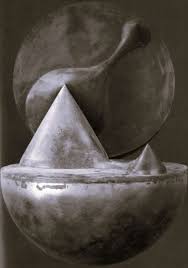
The works of the artist Franco Nicolosi come from a deep intimate reflection. A sort of continuous sensorial interconnection where matter translates into an unexpected creative process, albeit meditative. An experiential practice, characterized by forms with unmistakable, sinuous and rhythmic traits. Forms that seem suspended between past and present, but that open to a constant and lasting dialogue. Here then are vases and drawings made with different materials, including clay, graphite, wood or ceramic. And, although each work follows a different specific path, they all eventually intertwine again, triggering reflections on concepts such as duplicity, symbolism, awareness and transformation.
A reflective, dreamlike, harmonious art, which we find in works such as Contenitore tragico (2024), Riflessioni di Superficie (2024), Flussi (2022), to the work Fritz, un elefante a corte (2015). Let’s talk about it with the artist.
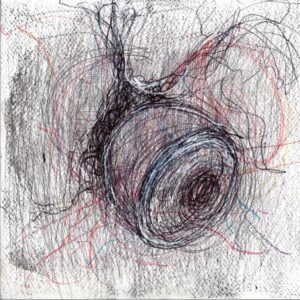
Your works emerge through an unusual dialogue with matter. The shapes or signs, in fact, seem to settle in an abstract, almost dreamlike space, to then materialize in gestures of transformation and revelation. Can you tell us how your creative process is triggered?
Sometimes my creative process comes from a vision, while other times during the practical stages of making a drawing or a sculpture. It is certainly a slow process, a sort of distillation, in which all the elements undergo a sort of dematerialization which then allows to recompose themselves into new forms. It is a process that does not always, indeed rarely, reach completion, always forcing me to start over from the beginning.
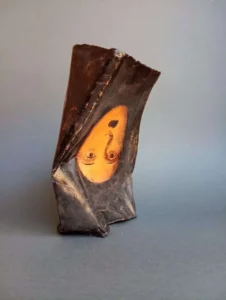
Sculpture and drawing are the artistic practices you prefer. On the one hand, clay with its material, malleable essence; on the other, graphite with its unstable, yet tameable, signs. What differences characterize these two creative acts?
Drawing is definitely my source of nourishment, exploration and ideation. In drawing all the strength of the gesture can explode, and the small space of the sheet becomes a universe of energy in which the lines collide with each other. The sign then becomes a passable boundary through which I can make the forms dance. In sculpture, although more plastic and tangible, the inconsistent takes shape and a vision, sometimes abstract, of the objects which surround the human being materializes.
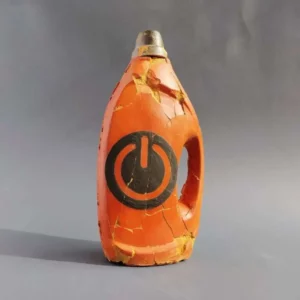
Often your sculptural works deal with themes related to time, in particular to the past and the future, as in Contenitore Tragico (2024) or ON – E FUTURE – Bottle I/01 (2023). Through symbols of contemporary consumption, sculpture thus becomes a space to tell, and unite, different and distant experiences. How much does the concept of time and space affect your work?
Space, the becoming space of sculpture, together with time are the two basic concepts of my art. I am very fascinated by the ability of the painter Francis Bacon to illustrate space and time, crystallizing on canvas these concepts dear to me. The border of a space or a surface unites or divides, contains and isolates; but often allows migration and favors passage and transformation. Sometimes, in my mind, past, present and future enter into a dialogue through lines, shapes and objects. Into imagination, as into a dream, the dimension of time relates with space, building a four-dimensional form.
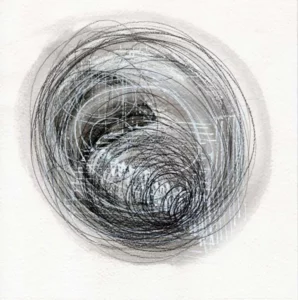
Water is another constant motif in your artistic research. In drawings such as Ramificato (2022) or Vortice (2022) this element seems to merge with the matter itself, to then explode violently in floating and somehow free, pulsating vortices. Can you explain why water has such an important role in your creations?
What I appreciate about water is its slow but inexorable force, its ability to shape materials also thanks to its chemical-physical structure, and therefore to the infinite spaces it can inhabit. Water is an earthly element capable of connecting all the elements of our Planet. Also, what I like about water is its ability to be an impalpable and ephemeral mirror in which the reflection preserves its inconsistency and fluidity. Water generates dynamic reflections that transfigure bodies.
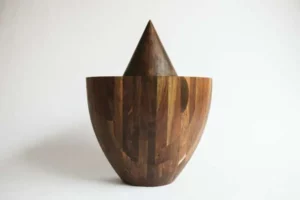
Let’s talk about the work Riflessioni di Superficie (2024). In this case, wood was used to carve lines over other lines in order to create something completely new. Can you tell us about how you created this work and why you chose this material?
I grew up surrounded by wood, with my little child legs literally sinking into the sawdust, breathing in the resinous essences of pine and fir boards inside my dad’s workshop. I love this material because, unlike the long-lasting marble, it is in a continuous and perpetual transformation and, thanks to its limited size, it forces me to carry out assembly operations that unexpectedly and astonishingly influence the final form of the work of art. Joints, variations in grain and color, cracks and fissures transform the sculpture, bringing it to a new life.
Another aspect emerging from your modus operandi is the duplication of forms. A sort of double gaze that allows you to observe images as in a mirror, first separating them, then reflecting them in something new, unique. What role does this type of vision have in the conception of your work?
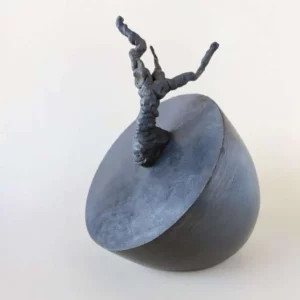
The infinite study of form is hidden in the reproduction processes. I cover the raw clay with plaster, thus creating the cast, the imprint, where what is a mass becomes a void. I love metamorphic substances and materials, or rather those elements that are able to be modified and shaped in an almost infinite game, which leads the forms to extreme and unexpected solutions. The work of shaping and duplicating sculptural works always allows me to pass to the other side of the mirror and observe the form in a new way. I am always ready to be surprised by the wonder that is revealed under the surface of a mold. If the product of the sculpture is defined, all the production and replication processes are not and allow me to linger in that enchanted space where nothing is quiet and serene. Calcing clay, creating silicone shells, crushing, turning, shattering, welding, patinating are among the actions I love to do when I am immersed in creative processes. All the techniques, procedures, studies that sculpture brings with it allow me to observe the forms as if I were always moving here and there in the mirror, as if there were no real border, no limit. I am attracted by the concavities in the volumes perhaps because of that sense of disorientation that comes over me when the work suddenly reveals itself while the soft shell falls onto the workbench, forgetting its original construction and leaving space for the final structure. Sculpture is an immaterial body where the border leaves space for its reflection.
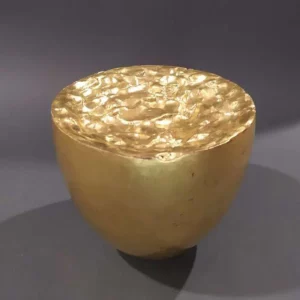
Oscillazioni (2023) and Mare dentro (2023) instead are inspired by two different literary works: a Chinese text in the first case, and the poem by the Spanish writer Ramón Sampedro in the second. However, both were created using terracotta gilded with gold leaf. Can you tell us about these two works and the symbolic use of this technique?
In the case of Oscillazioni, I was very fascinated by the idea of interstice, crack, empty space in which to descend to explore and create a sculptural form. While in the case of Mare Dentro, Sampedro’s story pushed my imagination towards this body of water agitated by a sea of footprints and crystallized by gold leaf which, as in the fourteenth century, allows me to isolate the work of art in an “other” and “beyond-human” space.
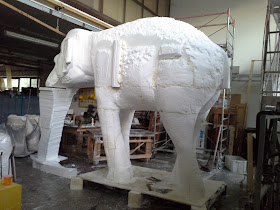
Fritz, un elefante a corte is a resin sculpture created in 2015 and preserved in the gardens of the Palazzina di caccia of Stupinigi. In January 2024 the work was transported to P.zza Castello in Turin, thus becoming the symbol of the rebirth of the Museum of Natural Sciences, which burned down a few years earlier. Can you tell us about this project, how it was created and what it represents?
I created the work in 2015 in collaboration with the students of the course for Theater and Cinematographic Scenography Construction Technician at the San Carlo Schools in Turin. The resin sculpture is a faithful reproduction of the elephant Fritz preserved in taxidermy in the Museum of Natural Sciences in Turin. After roughing out and modeling large blocks of polystyrene, we created the plasticine skin on them necessary for the reproduction procedure using a plaster cast. Once the mother mold was completed, and the large molds were opened, we laminated the epoxy resin with fiberglass. At the end, after closing the molds, we freed the sculpture from the covering and concluded the work with polyurethane paints to ensure the artifact had optimal resistance.
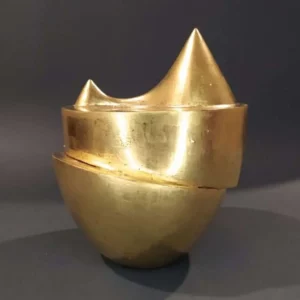
Are there any artists who have influenced your work or continue to inspire you?
Joseph Beuys for his role as an artist-shaman and for the magical relationship he was able to establish with Nature. Anish Kapoor for the evocative strength and purity of his forms, Giuseppe Penone for the sublime poetry that animates his artistic work. And Francis Bacon, who in his sometimes terrifying paintings tells me, through spaces and objects of use, of a human race that is part of the things that surround it and pass through it, shaping its body until it is transfigured.
What are your future projects?
I will continue to work on my obsession, that is objects as a reflection of man and his actions.